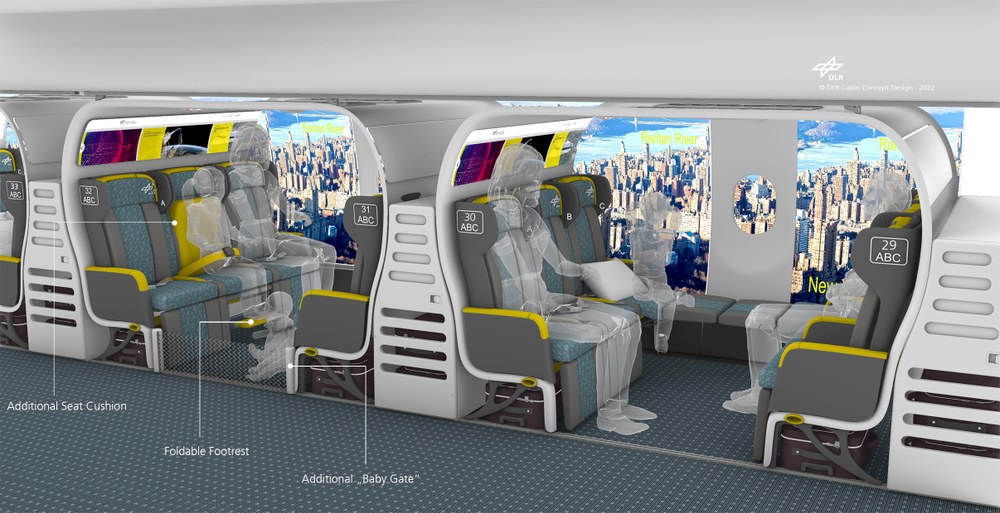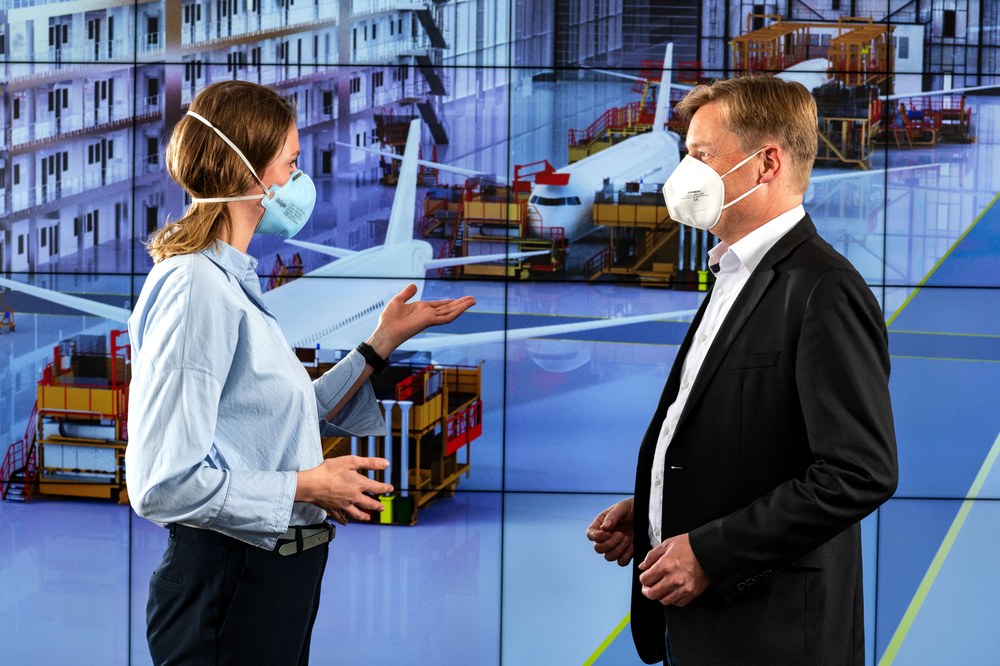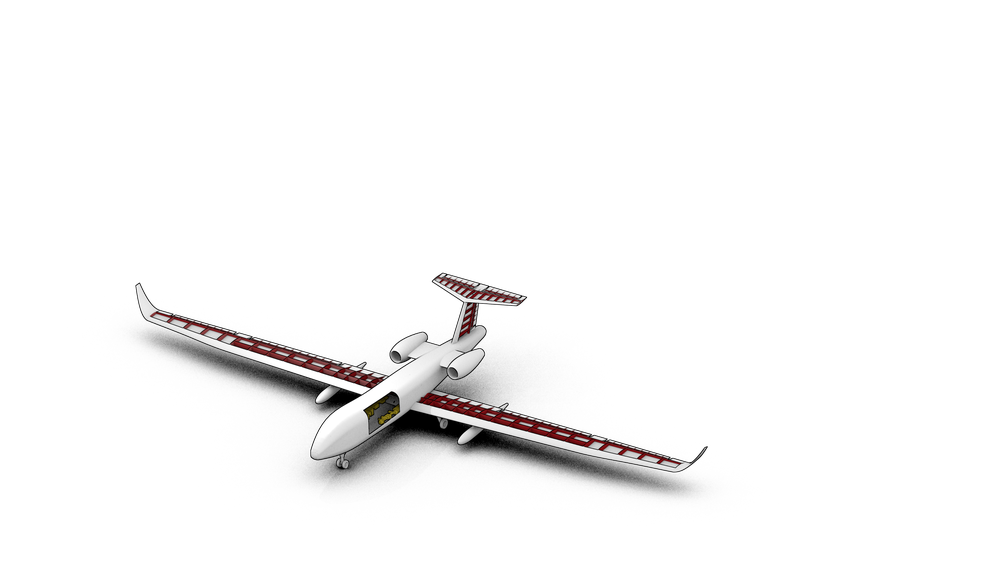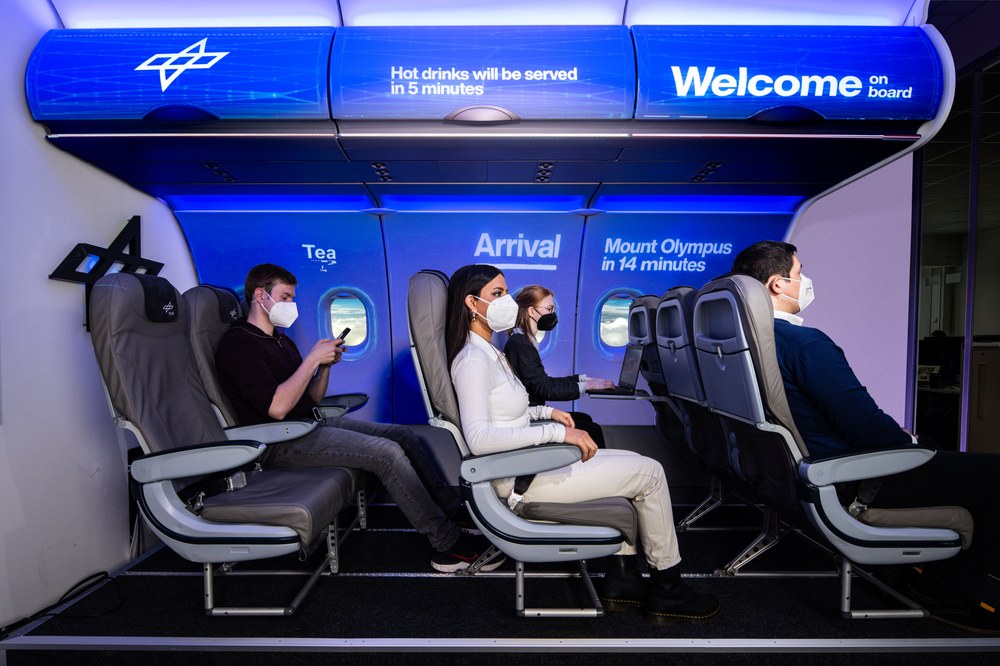Out of the box

Who decides on the appearance of the products that we use? Who designs them? The development of new products is not necessarily dictated from above: designers can enter into direct dialogue with users and allow them to help shape the development process. This collaborative approach is known as codesign. At DLR, researchers are keen to apply this fundamental concept to the development and production of aircraft in order to improve the joint development process – from the initial idea to production and operation.
Designers begin thinking about the appearance of a new aircraft long before the first prototype is built. This can lead to the inclusion of ideas such as large panoramic windows or a lounge area with a bar for passengers. It is also at this stage that the designers consider how the aircraft can meet the climate neutrality goals that have been set for aviation, how many passengers it should accommodate, which routes it will need to fly and how it will be powered. This requires input from a wide range of experts in fields such as aerodynamics, structural engineering, acoustics, safety and structural dynamics. They must work closely together, examine how all their requirements can be implemented efficiently and how the aircraft has to be designed so it can fly. This means that new aircraft can be brought to market more quickly.
Swift, collaborative and full of promise
"The notion of applying co-design to the entire development process was first raised by production, because they often only see a design when it is almost finished," says Jörn Biedermann of the DLR Institute of System Architectures in Aeronautics in Hamburg. Researchers at the institute are working to improve the performance, safety and efficiency of new aircraft and their components, such as the cabin.
"We are working together to develop ideas and define interfaces. Specifically, we are gathering all the necessary information and compiling it in a way that everyone can understand."
Mara Fuchs, DLR expert for cabin system design
Some issues are only identified once a design is submitted to production. It may become apparent that existing production technologies need to be extensively modified as they are not designed for tasks required. Sometimes systems must be upgraded or new machinery procured because the existing ones are unable to carry out the necessary work. If an aircraft is significantly longer than those manufactured previously, for example, a new production hall may have to be built from scratch to house it. Many systems are also currently optimised for just one type of aircraft. However, future aircraft will have a more modular design. Depending on the requirements, the rows of seats may be arranged differently, for example, or sleeping cabins and work areas may be incorporated into the design. These design features will naturally affect aircraft production.

Adopting a co-design approach offers all parties the chance to provide input at each stage of the design process, from concept and design development to dimensioning, testing, production, operation and maintenance. Specialists from all areas are asked about their requirements and constraints from the outset. As a result, these factors are integrated into the process at an early stage and everyone works together and in parallel on the design, saving time and money. The researchers and engineers in Hamburg expect that this approach will not only improve communication, but that it will also lead to the development of more efficient processes and more innovative aircraft concepts.
Finding interfaces and making information accessible
"We are currently concentrating on co-development, which refers to the linking up of the various aspects of the design phase," says Fabian Reimer. Reimer works in the cabin design team at the DLR Institute of System Architectures in Aeronautics. "We are working together to develop ideas and define interfaces," says Mara Fuchs, DLR expert in cabin system design. "Specifically, we are gathering all the necessary information and compiling it in a way that everyone can understand." In doing so, the DLR researchers are including every development phase that an aircraft goes through during its lifetime. This is no easy task, as the various experts all work with different software programs and methods. In order to assess whether a new concept is airworthy, researchers create flow models, acoustic analyses, Finite Element Method (FEM) simulations that show whether the structures can withstand loads during flight, and more. The newly developed concepts are subject to strict safety regulations as part of their certification. Information about these requirements and much more are currently often exchanged between departments via an Excel file or PDF document. Such a document can consist of up to 1000 pages, from which every expert must pick out the information relevant to them.
"At the manufacturers, teams are responsible for a specific aspect of the aircraft, such as how the airflow in the cabin should be regulated or how to make a turbine as quiet as possible. They optimise this within the given framework conditions," says Christian Hesse, DLR cabin design expert. "This means that they may not be aware of what is happening elsewhere within the overall aircraft system," adds Fabian Reimer.
This in turn leads to a situation in which supposedly effective improvements have little impact on the overall system. For example, when an advanced design was developed for the rotor blades of the contrarotating open rotors engine type, experts assumed that this could reduce noise by 10 to 20 decibels. When considered in isolation, this was certainly the case. However, when the engines were then mounted on the fuselage structure and tested in a wind tunnel, researchers noticed that the aircraft was only approximately two to six decibels quieter, as noise is also generated by the airflow around the aircraft structure. "Only when we all sit down together do we uncover specific interfaces and interdependencies between the specialist areas. And only then can we take them into account at an early stage," says Mara Fuchs.

Everything is connected – the aircraft as a system
For Biedermann, co-development is a promising approach that can be used to identify previously unrecognised interfaces. "Now we see the entire aircraft as a single system in which everything is connected," he says. "With the help of co-design and co-development, we can prompt people to think outside of their own box." This approach provides an opportunity for experts to exchange ideas and gain insight into the work of others. It makes the various interactions visible and enables researchers to give each other feedback and respond to each other's needs.
Co-design and co-development at DLR ...
This approach is proving effective among the DLR institutes conducting research into aeronautics. Since 2005, DLR researchers have been developing the Common Parametric Aircraft Configuration Scheme (CPACS). This data model contains information about the design of an aircraft and its individual components. The data are issued in a format that is readable and usable by all parties. It ensures that everyone has the same overview of the aircraft at all times and is working with the latest data. It also eliminates the need to wade through a 1000-page PDF file. In DLR's Innovative Digital Cabin Design (InDiCaD) project, researchers investigated the direct exchange of cabin design data using CPACS. This process allowed experts to take the results of passenger boarding simulations into account in the design and exchange information about predicted cabin noise.
In the AGILE project, this collaboration was extended to partner organisations across Europe. "We were able to show that it is possible to design an aircraft in a decentralised way in Europe, with everyone working on the same digital foundation," says Luca Boggero, DLR systems engineering expert. The many different methods and digital tools involved in the design process were linked together as part of the project. The Verdika project focused on the aircraft cabin and how it can be developed digitally in a collaborative way. In 2020, DLR launched the Exploration of Electric Aircraft Concepts and Technologies (EXACT) project, in which 20 institutes are jointly developing concepts for eco-efficient commercial aircraft. The project will run until 2024.

... and beyond
When Biedermann and his team set to work introducing co-design principles to aircraft design, they are often met with a significant challenge at the outset. "Depending on who I talk to, I may be given a different description or different requirements for the virtual and real product," says the DLR researcher. Operations may require that an entire fleet is presented as a digital product following each modification. Meanwhile, production may be more interested in depicting the current status during assembly. As a result, defining the terms can be an almost philosophical dilemma. The task of the DLR experts from Hamburg is to create a common foundation and link up the different areas of expertise. To do this, they develop knowledge-based methodologies that answer questions such as: Which information is relevant? How can I link up this knowledge? Who is connected to whom? Everything has to be consistent.
The DLR Institute of System Architectures in Aeronautics and Dassault Systèmes are looking to apply this approach in industry as part of the Engineering Collaborative Network project. Everyone involved is using Dassault's existing software platform to communicate with one another and make themselves aware of changes to the aircraft design. The DLR team will investigate remaining gaps in communication and collaboration and look at how these can be rectified – preferably together, of course.
DLR's projects from the field of co-development
Developing new cabins together

The Verdika project for a networked digital cabin was part of the Federal Aviation Research Programme VI-1. Here, DLR researchers worked with partners from industry, including Airbus and Diehl Aviation, to devise a process for the automatic digital development and integration of aircraft cabins. The project focused on overhead compartment designs for different types of aircraft. All parties involved in the project came together at an early stage to investigate a modular luggage compartment design and methods for integrating it into various aircraft types. The project will end in September 2023.
A testbed for collaboration
The DLR Institute of System Architectures in Aeronautics has launched the Engineering Collaborative Network initiative together with the technology provider Dassault Systèmes. The initiative seeks to determine how industry can benefit from a more collaborative way of working. To do this, researchers use the 3DEXPERIENCE software platform developed by Dassault Systèmes. This integrated, cloud-based platform allows all parties involved to collaborate, communicate and track changes to the aircraft design made by others. The DLR team is working to optimise how value is added to the economic ecosystem for aeronautics, with a view to facilitating sustainable flight and meeting society's requirements for a climate-neutral future.
Digital aircraft design

ZENODO
Designing new aircraft can be very challenging. New designs are becoming increasingly complex, while the costs and time required are rising. The EU-funded H2020 project AGILE 4.0 aims to digitalise the design process, making it faster and more effective. AGILE 4.0 was launched in 2019 and will run until 2023. The participants are investigating new ways of modelling and optimising aircraft and evaluating these models. Their work covers the entire life cycle, including manufacture, certification and maintenance. Documents are no longer exchanged; instead, everyone involved has access to digital models that display all the relevant information.
An article by Björn Nagel from the DLRmagazine 172


